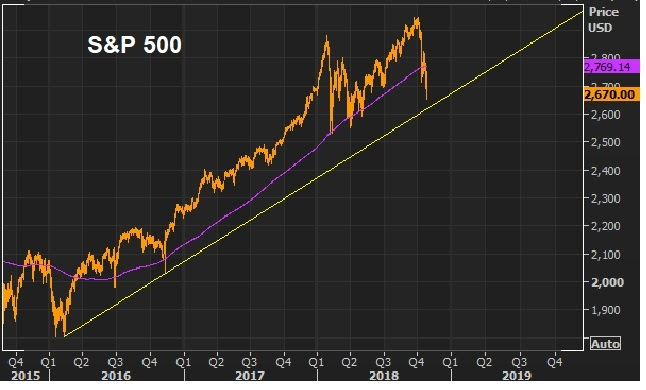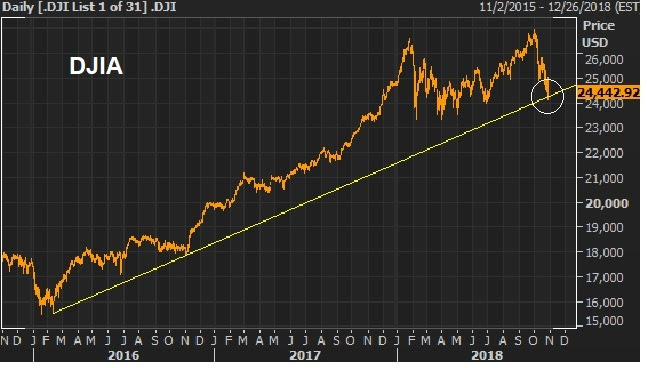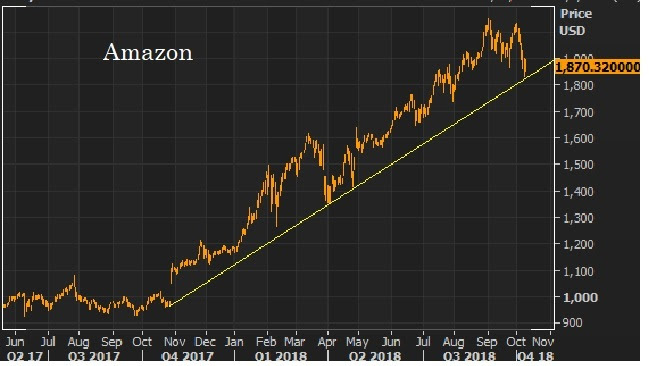|
|
|
October 25, 5:00 pm EST Yesterday we looked at this big trendline support in stocks (the yellow line).
|
 |
|
We had a good bounce today, but experience tells me that we will make a run at that trendline, and things will look a little messy before we bottom. We still have seven trading days before the mid-term elections. A stock market in correction is not as easy to promote as one at record highs (as we had just earlier this month). With that, I suspect there are plenty of interests (China among them) to keep the pressure on stocks in hopes of dividing U.S. Congress come November 6th. When the dust clears from the elections, market folks will realize that stocks are incredibly cheap at 15 times next year’s earnings estimates, in an economy growing better than 3%. On that note, we have our first look at third quarter GDP tomorrow. The market is looking for 3.6% growth, which would give us 3.22% annualized growth averaged over the past four quarters. That would be the best growth since 2006. If you need help with your shopping list of stocks to buy on this dip, join me in my Billionaire’s Portfolio. We follow the world’s bests billionaire investors into their favorite stocks. Click here to learn more. |
|
October 23, 5:00 pm EST
As we discussed yesterday, despite all of the drama about China, Italy,
Brexit, rates and the elections, what seems more likely to have driven the recent correction in stocks is Saudi selling.
In fact, I think it’s clear that there has been a Saudi liquidation (of U.S. and global assets) which was the catalyst for the correction in stocks earlier this year, and this recent decline.
Remember, in November of last year, the Saudi Crown Prince Salam, successor to the King, ordered the arrest of many of the most powerful Saudi Princes, country ministers and business people in Saudi Arabia on corruption charges. Over $100 billion in assets were claimed to be under investigation (a third frozen) in what was called the “Saudi purge.”
These subjects were detained for nearly three months. The timing of their release and the market correction of early this year is where it all begins to align.
They were released on Saturday, January 27. S&P futures open for trading on Sunday night. Stocks topped that night and proceeded to drop 12% in six days. And rallies in stocks were sold aggressively for the better part of the next seven months.
Fast forward to this month, and we have the murder of the journalist that was a public critic of the Crown Prince Salam. As the details of story pointed back to Salam, on Oct 3, U.S. bond markets got hit (to the hour of news hitting the wires) and stocks topped that day, and have proceeded to drop by more than 8%.
Clearly, the destabilization in Saudi Arabia has put considerable assets in jeopardy. With that, those in control of those assets have likely been scrambling to protect them, as U.S. Congress pushes for sanctions, which could include freezing Saudi assets.
|
October 22, 5:00 pm EST As the events surrounding Saudi Arabia continue to unfold, it is beginning to look more and more like the market shakeup of the past three weeks was triggered by Saudi selling. The top in stocks and the heavy selling came just as news was hitting wires that Khashoggi never exited the Saudi consulate in Turkey – disputing the story of the Saudi government. Stocks put in a top that day.
|
 |
|
And that was the day the bond market also made it’s move — the 10-year yield spiked from 3.08% to 3.18%.
|
 |
|
Here’s what hit the news wires that triggered the selling in bonds/rise in market rates – to the hour.
|
 |
|
So, was the catalyst for this market correction triggered by money from Saudi Arabia moving to escape a potential asset freeze? It looks possible. We constantly hear predictions of impending corrections, pointing to all of the clear evidence that should drive it, but corrections are often caused by events that are less pervasive in the market psyche. The Saudi story would qualify. If you need help with your shopping list of stocks to buy on this dip, join me in my Billionaire’s Portfolio. We follow the world’s bests billionaire investors into their favorite stocks. Click here to learn more. |
|
October 18, 5:00 pm EST Last week, we talked about the signals coming from China, that the economy is running dangerously slow, and their backs are against the wall. They cut their bank reserve requirement ratio last week for the fourth time this year. And they have been continually walking down the value of their currency (the yuan). The PBOC pegged the yuan to another 21-month low today. Most importantly, it’s getting closer and closer to the 7 yuan per dollar level – a level we haven’t seen since the pre-financial crisis days. As we’ve discussed, they have two options. They can play ball on trade concessions with the U.S. If so, the economy slows. They can continue to holdout/pushback on trade, and the trade sanctions may take the economy off the cliff. Both scenarios mean China’s rapid ascent to economic power gets knocked off path. If holdout is their long term strategy, I suspect we will find that global trading partners will join Trump’s fight against China’s rigging of global trade via its weak currency advantage. That’s not a good outcome for China. More likely, China is trying to holdout to see the outcome of the November U.S. elections. And as we discussed earlier this month, they are likely trying to wield some influence: “they can sell Treasurys, in an attempt to ignite a sharper climb in rates. And a fast move in rates (at these levels) has a way of shaking confidence in equity markets–which has a way of shaking confidence in the economy.” It appears that it may be playing out, but worse for Chinese stocks, which are now down 25% for the year.
|
 |
|
If you need help with your shopping list of stocks to buy on this dip, join me in my Billionaire’s Portfolio. We follow the world’s bests billionaire investors into their favorite stocks. Click here to learn more. |
Since stocks dipped last week, I’ve heard the chatter (again) about how a 3% 10-year note has suddenly created a high appetite for Treasurys over stocks (i.e. people are selling stocks in favor of capturing that whopping 3% yield).
But in this post-crisis environment, a rise toward 3% promotes the exact opposite behavior. If you are willing to lend for 10-years locked in at a paltry rate, you are forgoing what is almost certainly going to be a higher rate decade than the past decade. If you need to exit, you’re going to find the price of your bonds (very likely) dramatically lower down the road.
Coming out of a zero-interest rate world, bond prices are going lower/not higher. Here’s the chart of the 10-year Treasury note (price). You can see we’ve now broken the three and a half decade bull market in bonds (yields go up, as bond prices go down) …

stocks
Bottom line: The bond market is the high risk-low reward investment in this environment. And there continues to be plenty of fuel for stock prices as money exits bonds.
|
|













